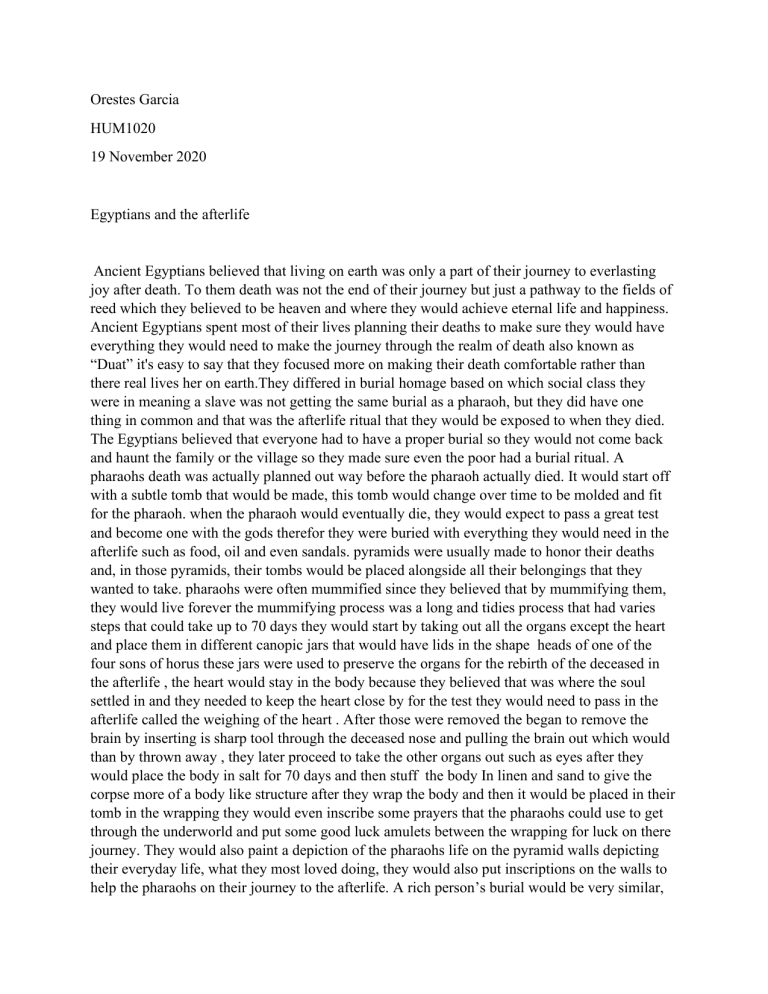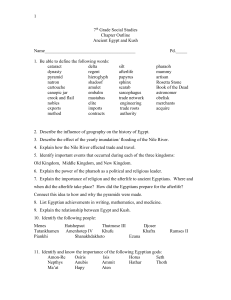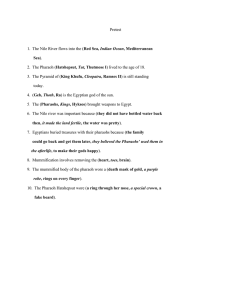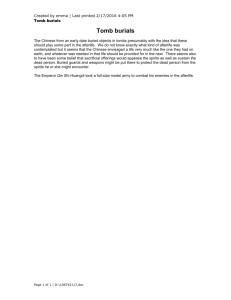
Orestes Garcia HUM1020 19 November 2020 Egyptians and the afterlife Ancient Egyptians believed that living on earth was only a part of their journey to everlasting joy after death. To them death was not the end of their journey but just a pathway to the fields of reed which they believed to be heaven and where they would achieve eternal life and happiness. Ancient Egyptians spent most of their lives planning their deaths to make sure they would have everything they would need to make the journey through the realm of death also known as “Duat” it's easy to say that they focused more on making their death comfortable rather than there real lives her on earth.They differed in burial homage based on which social class they were in meaning a slave was not getting the same burial as a pharaoh, but they did have one thing in common and that was the afterlife ritual that they would be exposed to when they died. The Egyptians believed that everyone had to have a proper burial so they would not come back and haunt the family or the village so they made sure even the poor had a burial ritual. A pharaohs death was actually planned out way before the pharaoh actually died. It would start off with a subtle tomb that would be made, this tomb would change over time to be molded and fit for the pharaoh. when the pharaoh would eventually die, they would expect to pass a great test and become one with the gods therefor they were buried with everything they would need in the afterlife such as food, oil and even sandals. pyramids were usually made to honor their deaths and, in those pyramids, their tombs would be placed alongside all their belongings that they wanted to take. pharaohs were often mummified since they believed that by mummifying them, they would live forever the mummifying process was a long and tidies process that had varies steps that could take up to 70 days they would start by taking out all the organs except the heart and place them in different canopic jars that would have lids in the shape heads of one of the four sons of horus these jars were used to preserve the organs for the rebirth of the deceased in the afterlife , the heart would stay in the body because they believed that was where the soul settled in and they needed to keep the heart close by for the test they would need to pass in the afterlife called the weighing of the heart . After those were removed the began to remove the brain by inserting is sharp tool through the deceased nose and pulling the brain out which would than by thrown away , they later proceed to take the other organs out such as eyes after they would place the body in salt for 70 days and then stuff the body In linen and sand to give the corpse more of a body like structure after they wrap the body and then it would be placed in their tomb in the wrapping they would even inscribe some prayers that the pharaohs could use to get through the underworld and put some good luck amulets between the wrapping for luck on there journey. They would also paint a depiction of the pharaohs life on the pyramid walls depicting their everyday life, what they most loved doing, they would also put inscriptions on the walls to help the pharaohs on their journey to the afterlife. A rich person’s burial would be very similar, but they would not get their own pyramids since they could not afford it, they would get tombs and they would also get mummified as well as buried with their prize possessions. The rich usually had the luxury to pick which kind of tomb they would like for their fellow deceased family member what kind of ritual they would be able to perform and also what they would like to be done to the body only the rich and wealthy could afford to take the organs out of the deceased body and place them in a container called canopic jars the rich could also get inscriptions on their tombs to help them on their journey through the realms of duat. Farmers would also get buried with what they wanted in the afterlife if they had anything they wanted to get passed over. most farmers would be buried in the sand since they couldn’t afford their preservations and they could not afford tombs with engravings on them, some could not even afford to get mummified or embalmed but the ones that could would use their own clothes to wrap up the body the ones that couldn’t not pay to be mummified or preserved just buried their loved ones in the sand which resulted in a good preservation since the weather was so hot and arid that it actually acted better at preserving the bodies then the embalming of the upper class. Usually, they were buried on the outskirts of town or even in cliffs their burials were a swift process since the whole mummification process wasn’t involved. From pharaohs to farmers ne on the most important details in their coffins if they had one were two holes that were made to represent the KA and the BA The first hole represented the “Ka” the holes made helped the soul travel to the underworld when the body died. After the “Ka” takes the journey, it returns to the body as the “ba” entering through the second hole by doing this the “Ba” is then able to have a free spirit. The slave's burials were cruel and even less then the farmers, usually slaves would get thrown in a pail and just covered with sand and left there. Most slaves were young and around the range of 7-25 very few made it past there teen years due to the hard labor and the poor conditions they endured. Even though burials differ from social status, what stays the same is the transition from life to death in the Egyptian world, the journey begins when the person dies and their soul called Akh reaches the underworld for judgment. they are then were encompassed in a vehicle of transportation that had a passage already destined for them the passages they would take would usually be determined by their ranking in the real-world. The vehicle of transportation was also determined based off your ranking in the real world while pharaoh was usually guided through the passages in a boat hence why some pharaoh were buried with boats alongside their pyramids less ranking individuals had no other than to travel using their coffins if they were buried in one. Anubis the god of the underworld comes a guide the soul to make sure they it wouldn’t get lost in the many realms of the underworld. For ancient Egyptians the judgment process was a 2 step process the first test consisted of the measurement of the heart in this test, the persons heart would be measured in the hall of truth with the goddess ma’at. Osiris the god of fertility would oversee this test on one side the heart would be placed in a scale and on the other side of the scale a feather from the goddess ma’at. Ma’at was known to be the goddess of truth, balance and justice so if the persons heart was lighter or equal to the feather then the person went through their life with justice and everything that the goddess ma’at represents therefor they would pass the first judgment. But if the heart was heavier than the feather that person did not follow the representation of balance or justice therefor, they were condemned and were to be devoured by Ammit since ancient Egyptians didn’t believe in hell ammit the devourer of the unworthy dead would eat them and they would cease to exist a concept that for the ancient Egyptians was scarier then hell. When you cease to excuse that would mean that you would not be reincarnated and you would not enjoy eternal life. The ones that made it past the first judgment were later passed on to be judged by forty-two gods in this test the forty -two gods would each look for a specific sin and it was up to the person to convince the gods that they didn’t do the sins they were being accused of. Ancient Egyptians had a book of dead that had rituals, recommendations and ways to pass the two tests that they were going to be presented, in that book it was said that in the second test the person should know the name of each god that was there and also gave tips on which sins were going to be put forth to be judged making it easier for the person to create a good argument and pass the second test. For a pharaoh every was the same except that the village people would wait to see if the pharaoh had passed successfully to the fields of reed by waiting for the sunrise , typically it is said that the tests and the paths of the underworld took up to 12 hours to complete so they would make their voyage at night so by the time that everything was completed the sun would rise to a new day for the villagers and a new life for the pharaoh After the second test and each god was convinced, then your soul was allowed to pass to the fields of reed by crossing the lake of flowers there they would be reunited with loved ones, old pets and even their old home, there in the fields of reed one would never die. What was very unique about the Egyptians belief in the afterlife is their concepts of not believe in hell and its eternal torment they believed in something way worse which was ceasing to exist all together, they also loved the idea of being able to live forever in a place almost mimicking their earth like lives they couldn’t imagine something better than what they already had. Usually, they were buried on the outskirts of town or even in cliffs their burials were a swift process since the whole mummification process wasn’t involved. From pharaohs to farmers ne on the most important details in their coffins if they had one were two holes that were made to represent the KA and the BA The first hole represented the “Ka” the holes made helped the soul travel to the underworld when the body died. After the “Ka” takes the journey, it returns to the body as the “b entering through the second hole by doing this the “Ba” is then able to have a free spirit. The slave's burials were cruel and even less then the farmers, usually slaves would get thrown in a pail and just covered with sand and left there. Most slaves were young and around the range of 7-25 very few made it past there teen years due to the hard labor and the poor conditions they endured. Ancient Egyptians had a book of dead that had rituals, recommendations and ways to pass the two tests that they were going to be presented, in that book it was said that in the second test the person should know the name of each god that was there and also gave tips on which sins were going to be put forth to be judged making it easier for the person to create a good argument and pass the second test. For a pharaoh every was the same except that the village people would wait to see if the pharaoh had passed successfully to the fields of reed by waiting for the sunrise , typically it is said that the tests and the paths of the underworld took up to 12 hours to complete so they would make their voyage at night so by the time that everything was completed the sun would rise to a new day for the villagers and a new life for the pharaoh After the second test and each god was convinced, then your soul was allowed to pass to the fields of reed by crossing the lake of flowers there they would be reunited with loved ones, old pets and even their old home, there in the fields of reed one would never die.


